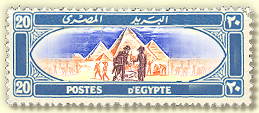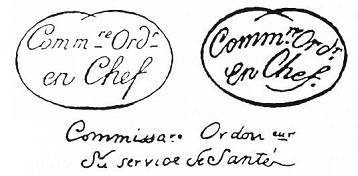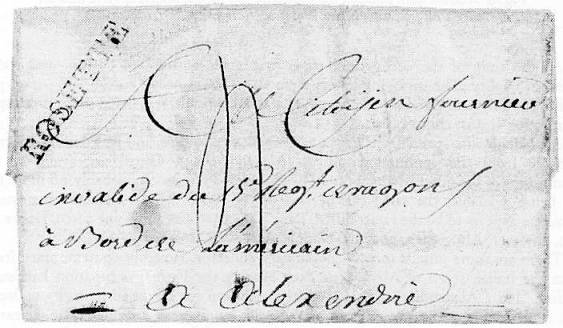

|
The first handstamped postal markings of Egypt are those of the postal system organised by Napoleon Bonaparte during the French occupation of Egypt from 1798 to 1801. The chronology of the Napoleonic campaign begins with the sailing of a French army from Toulon, the naval base near Marseille, on May 19th 1798. The convoy evaded Admiral Nelson's fleet and arrived off the coast of Egypt on July 1st. Landing commenced immediately at Marabit, west of Alexandria, which was successfully assaulted on July 2nd. The French arm), proceeded up the Nile to Cairo, retching it on the 21st; by July, 27th Cairo was fully invested. Nelson's fleet soon discovered the French fleet at anchor in Aboukir Bay, just east of Alexandria, and destroyed it in a battle lasting from August 1st to 2nd, thereby stranding the French army. A landing was not made, however, and the French were left in control of Egypt. They soon spread their control throughout the country, reaching as far south as Assuan, which was captured on February 2nd 1799. Two attempts by, Turkish armies to dislodge the French were unsuccessful, although they retched as far as Heliopolis (March 1800). Bonaparte: carried out campaigns into Syria from his Egyptian base, and some of the surviving correspondence deals with these campaigns. The occupation of Egypt came to an end in 1801. A British force defeated the French near Alexandria in March 1801. Reinforcement by Turkish armies as well as troops from Fast India led to the surrender of Cairo on July 27th. The city of Alexandria held out until September 2nd. Following these events, the French occupying forces and accompanying civilians were repatriated to France in an orderly manner.
There are two types for Alexandria and Siouth2 Type II of Siouth (23.5mm.) developed a progressive split in the letter I, causing it to resemble a Y. I have not seen Type I (26mm) Strikes of SIOUTH it are often overinked and oily, making measurement difficult, and the appearance of the letters may vary. For this reason the distinction between Type I and Type II is difficult and some students believe them to be from the same handstamp.  Fig. 2 Named Handstamps. Letters are known addressed to Menouf, Mansura, and Samanoud, so those places presumably also had post offices. Some offices are known only as manuscript markings (e.g., Bilbeis). It has been suggested3 that offices may also have existed at Assuan, Qena, Girga, Fayum, Esna, Kosseir, Aboukir, Tanta, and Katieh (Sinai). A letter is known headed "Minia", but bearing a Benesouef handstamp, and one headed "Bilbeis" but handstamped at Cairo. A different sort of handstamp found on some letters consists of a kidney-shaped frame, within which is the inscription, in cursive script, "Commre Ordre / en Chef" (Commissaire Ordonnateure en Chef). There are two types: in one, the inscription is in horizontal lines; in the other, the lines are curved, convex upwards (Fig. 3).  Fig. 3 The 'Commissaire' handstamps. These handstamps occur on letters headed at Cairo, and may occur by themselves or accompanied by the LE CAIRE handstamp. Two examples only are known of a third type4. Most of the strikes of the handstamps are in black, but Benesouef and Siouth are known in red only; Le Caire exists in red, but is rare in that color. Offices having handstamps and dates recorded
Letters are known throughout the period of the occupation, but the dates can only be determined when the actual letter is included. Fortunately, this is generally the case, for envelopes did not exist at that time, and letters were written on one large sheet of paper, which was then folded up and sealed. The dates shown in the table above are expressed in the Gregorian calendar, although the dates are always written in letters in the Republican calendar, which bears no simple relation to the conventional Gregorian or Julian calendars. Some letters also have the Gregorian date at the head, written in a contemporary if not identical hand, but most do not. A typical date might be written "le 28 Nivose - an 9". This can be converted to "18th of January, 1801" in the following manner. The base point is September 22nd 1792, the date of the proclamation of the French Republic, and therefore Day 1 of Year 1. Thus "an 9" begins 8 years later, September 22nd 1800. Next, one must know the Republican months, each of which was exactly 30 days (the left-over five days were designated as festivals, Sept. 17-21):
Therefore, counting 28 days from December 21st brings its to January 18th and the next year, 1801. The confusion resulting from the use of this calendar when the rest of the world used the Gregorian or Julian and had no interest in learning the Republican calendar led to its abandonment at the end of 1805. In the case of letters from Alexandria, another clue to the date is the type of handstamp used. The large type, ALEXANDRIE, was the first one used; the small one, "Alexandria", appears to have come into use in 1800, and is not so scarce. There: are usually no rate markings, since most letters were internal mail. Some, however, have manuscript numerals (Fig. 4); "4", "8", and "l0" have been seen. The significance is not known, for they can be found on purely military mail. One can speculate that letters were normally prepaid (or were exempt), and needed no rate mark,  Fig. 4 A cover from Rosette showing a manuscript rate marking "4" (decimes). but unpaid letters might have been marked with the amount due (presumably in declines). The charge: was perhaps based on a combination of weight and distance. Letters for destinations outside Egypt (perhaps invariably Prance) are rare. The British fleet maintained a blockade, and only small, fast ships could slip through. Mail to France was thus infrequent and fraught with risk. That which has survived is more or less worn and dirty, in contrast to the generally clean and crisp state: of internal letters. In addition to the handstamp of origin, covers generally bear a French entry mark: "V. D. M. P. Toulon" (voie de merr par Toulon) or VOYE DE MER / PAR MARSEILLE. They also have manuscript rate markings (Fig. 5).  Fig. 5 A cover sent through the blockade to France, showing VOYE DE MER handstamp at top center, and manuscript rate "16" (decimes). At the time of the occupation, paper was made entirely of cotton, and was of excellent quality. The surviving letters seem all to be on heavy cotton laid paper, pure white, and still strong and supple. Some are stained, a result, it is believed, of dipping for disinfection against cholera. All Napoleonic covers from Egypt are very scarce to rare, and it is doubtful if more than 20 from the commonest offices (Alexandria and Cairo) are available. The handstamps of the other towns must all be considered rare, with probably no more than ten being available; the same can be said of the "ARM. DE I A MEDnee" handstamp. Damiette appears to be the rarest office. Type I ALEXANDRIE and Type I SIOTH are also rare, however. Altogether about 130 Napoleonic covers are known. There are some pitfalls to trap the unwary collector. Roughly contemporary letters from the Italian town of Alessandria exist bearing the French occupation handstamp reading "108 / Alexandrie". These are often mistaken for Egyptian items by collectors and dealers alike. The presence of the district number is an immediate giveaway. Furthermore, the dates (when they can be determined from the enclosed letter) do not fall within the period of the French campaign in Egypt, and the destinations are Italian. It is also worth knowing that there is a town in Italy named 'Cairo'. Covers from there are occasionally mistaken for Egyptian covers. The French never used the Italian form, 'Cairo', of course, but used `Le Caire' (rarely, 'Kairo'). When the British forces landed in Egypt in 1801, there was an immediate, if temporary, need for sending letters home. Apparently no formal army postal service was formed, however. Letters from the forces were sent without any handstamps of origin, and can be identified only by the content. They did, however, receive handstamped markings on arrival in Britain. They were received as ship letters, and the usual handstantp is a double-lined oval with a crown in the center and the inscription SHIP LRE across the top, and the name of the port (Falmouth, Plymouth, etc.) across the bottom. The dates are 1801 and 1802. References:
|